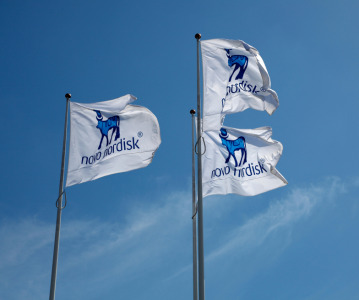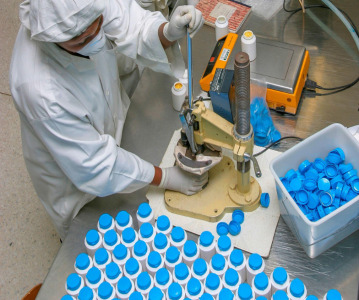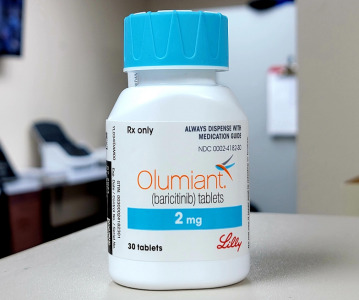It’s time for the pharmaceutical sector to do the smart thing

For many years, well before the arrival of COVID-19, the pharmaceutical sector has faced increasing pressures, with challenges such as fake goods and grey market diversion. There is also increased emphasis on how to ensure patient adherence, as this directly correlates with improved outcomes. Here we examine how recent developments in flexible electronics, RFID and smart packaging could help in these areas.
Gillian Ewers, VP Marketing, PragmatIC
Challenges
Counterfeit goods
The worldwide pharmaceutical industry has experienced significant growth during the past two decades - revenues worldwide totalled $1.25 trillion in 2019. The value of the counterfeit market is also considerable, estimated at $200 billion, of which online sales account for around $75 billion. The World Health Organisation (WHO) states that 16% of counterfeits contain the wrong ingredients and another 17% contain the wrong levels of necessary ingredients, meaning that a large proportion of these illegal medications could be harmful and sometimes even fatal.
To combat this, regulatory authorities have been putting various measures in place. For example, the European Falsified Medicines Directive (FMD) regulation which requires pharmaceutical companies to include a unique identifier (UID) and an anti-tampering device. These are used by suppliers to verify and authenticate the products prior to distribution and can be used by retail and consumers to ensure integrity up to the point of consumption or application. Currently companies use 2D barcodes for the unique identification which requires digital printers. These codes are easy to replicate, can get damaged in transport and are difficult to read in large numbers.
Grey market diversion
Another challenge is grey market diversion, which is when products are not counterfeit but are sold outside approved supply agreements. This could be goods that are bought in a low-priced region, and then sold in another for a much higher price, or it could be medicines that are OTC (Over The Counter) in one country, but under prescription, or prohibited in another territory. Therefore, grey market diversion is not only a problem for suppliers, but also for consumers. Buying from grey market sources because of differences in price is not illegal, but those products may come without local language instructions or information, which could have consequences for the user.
Patient adherence
There may be many reasons why patients do not complete a course of medicines or take the right amount at the right intervals. Time management, forgetfulness, difficult to read instructions, confusing counterindications, lack of knowledge and understanding are all important issues. The consequences are not only a waste of valuable resources, but it can also result in worsening conditions and increase the overall costs of treating the patient.
Technology to the rescue
Advances in flexible electronics and RFID (Radio Frequency IDentification) offer a promising solution to these challenges. An RFID inlay (or tag) can be added under labels or inside packaging, with an integrated circuit (IC) containing a unique identifier (UID). Using this technology manufacturers and retailers can quickly do stock checks, verify the supply chain and identify any hotspots of replicated codes. Assigning a digital UID enables item-level tracking through the whole lifecycle of a product, and crucially with RFID it is more difficult to counterfeit or tamper with as the inlay and IC are not visible and cannot be reprogrammed. With smart packaging patients could more easily access information about their treatment, ask for more details, contact support lines, all with a simple tap of a smartphone. There are also smart blister packs and medicine trays available, that can link with an app to help remind the patient and report quickly if non-adherence becomes an issue.
RFID technology is not new. It has been used for supply chain management in the apparel sector for some time, with considerable success, but previously the costs were too high for use in large volumes, or on low margin items, due to the cost of the conventional electronics involved. Fortunately, recent developments mean that now it is possible for the pharmaceutical sector to do the smart thing to tackle challenges such as counterfeit goods, grey market diversion and patient adherence. This item-level digital monitoring technology also has potential to extend into the tracking of millions of pathology samples and vaccines, and in future could be combined with sensors to track the temperature of items during transportation. And there are many other applications in the healthcare sector. We see an exciting future enabled with this technology, helping to increase efficiencies, reduce costs and improve patient outcomes, and it starts now.
Related News
-
News Women in Pharma: Moving beyond discussions and into best practice at CPHI Milan
In this second CPHI Milan special of our monthly series, we cover the key takeaways from the Diversity & Wellbeing track held on October 10, 2024. -
News AstraZeneca invests in AI collaboration for cancer drug trials
The British-Swedish pharmaceutical giant is partnering with biotechnology firm Immunai Inc to increase the efficiency of some cancer drug trials. -
News Ozempic and Wegovy prices questioned as Novo Nordisk faces US Senate hearing
The CEO of Novo Nordisk was grilled during a US Senate committee hearing on September 24, 2024, in which the exorbitant prices of the Danish company’s blockbuster drugs Ozempic and Wegovy were called into question. -
News The BIOSECURE Act: implications for the pharma supply chain
On September 9, 2024, the US House of Representatives voted to pass the bill titled the BIOSECURE Act (the Act), which lists several Chinese companies in the pharmaceutical supply chain. The Act will prohibit American companies from contracting or doin... -
News On Track at CPHI Milan: Thermo Fisher Scientific Track Sponsor interview
With CPHI Milan just around the corner, we sat down with some of the sponsors for this year’s conference tracks to discuss the most pressing topics in pharma. -
News CPHI Milan Speaker Spotlight: Pharma Manufacturing and Localisation in Africa
In the run-up to CPHI Milan, we sit down with some of the experts and thought-leaders speaking at this year’s conferences. -
News US BIOSECURE Act passed by US House of Representatives
The controversial act, which has already impacted several foreign companies operating in the US, was passed by the House of Representatives on September 9, 2024. It is now headed for the US Senate before it can be signed into law by President Joe Biden... -
News Eli Lilly licenses rheumatoid arthritis manufacturing in Africa
American pharmaceutical company Eli Lilly has signed a partnership with Egyptian organisation Eva Pharma to localise manufacturing of rheumatoid arthritis treatments in Africa.
Position your company at the heart of the global Pharma industry with a CPHI Online membership
-
Your products and solutions visible to thousands of visitors within the largest Pharma marketplace
-
Generate high-quality, engaged leads for your business, all year round
-
Promote your business as the industry’s thought-leader by hosting your reports, brochures and videos within your profile
-
Your company’s profile boosted at all participating CPHI events
-
An easy-to-use platform with a detailed dashboard showing your leads and performance

.png)





